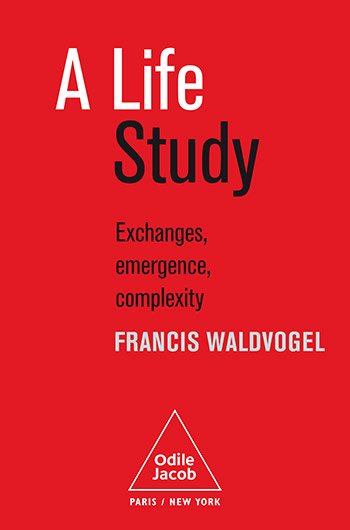Serge Haroche
The Science of Light From Galileo’s Telescope to Quantum Physics Serge Haroche, Nobel Prize in Physics Publication date : March 30, 2023
Odile Jacob Publishing to release The Science of Light, a captivating journey of scientific discovery by Nobel Prize-winning physicist Serge Haroche.
The Science of Light will be available for purchase worldwide in digital formats starting on Thursday, March 24, 2022, at odilejacob.com and on all retail platforms.
Serge Haroche is professor emeritus at the Collège de France, a member of the Académie des Sciences, a foreign member of the U.S. National Academy of Sciences, and winner of the 2012 Nobel Prize in Physics for discovering methods of manipulating and measuring individual quantum systems. He has taught at Paris VI University, the École Polytechnique, the École Normale Supérieure, Harvard University, and Yale University.
Serge Haroche
Nobel Prize in Physics
The Science of Light
From Galileo’s Telescope to Quantum Physics
Light has fascinated mankind since the dawn of time. Elucidating its properties over the centuries has been an adventure intimately linked with the birth and development of modern science; it has led, after many surprising twists, to the theories of relativity and quantum physics which have profoundly changed our view of the world at the microscopic and cosmic scales alike. Placing his own career in a rich lineage of scientific discovery, Nobel Prize–winning physicist Serge Haroche offers a literally enlightening account of what we know about light today, how we learned it, and how that knowledge has led to countless inventions that have revolutionized daily life.
From Galileo and Newton to Einstein and Feynman, from early measurements of the speed of light to cutting-edge work on quantum entanglement, Haroche takes a detailed and personal look at light’s role in how we see and understand the universe. The Science of Light is at once a colorful history of scientific inquiry and a passionate defense of “blue sky research”—investigations conducted not in pursuit of a particular goal, but out of curiosity and faith that today’s abstract discoveries may well power tomorrow’s most incredible possibilities.
A uniquely captivating book about the thrill of discovery.
Contents
FOREWORD 13
CHAPTER 1: The dawn of a vocation 21
First passions: from mathematics to astronomy 23
Introduction to modern physics 35
Shut up and calculate! 47
When atoms and photons are spinning tops: optical pumping 50
To see the world as something rich and strange 65
An apprenticeship in trust and freedom 77
Promises of the laser 81
Beginnings in research 85
First trip to America and return to my first passion 90
“Blue sky” research 93
CHAPTER 2: Reflections in the Observatory square 97
Two instruments at the origins of the scientific revolution: the refracting telescope and the pendulum clock 100
Measuring the speed of light to survey the universe 106
The science of light becomes quantitative: Descartes and Dioptrics 113
Nature works by the shortest and simplest ways: Fermat’s principle 118
Huygens and the wave theory of light 124
Newton, light particles, and color 134
Measuring the shape of the Earth 143
A passion for precision 156
Basic science, business, power, and technology 161
CHAPTER 3: Daydreams in Faraday’s laboratory 165
Young v. Newton 169
Light is polarized 175
Fresnel and the triumph of the waves 177
Combining vectors and interfering waves 181
A rotating vibration: circular polarization 187
Light illuminated by mathematics 193
Back to the speed of light 198
From the salons of the Enlightenment to Faraday’s laboratory 208
Birth of the concept of field 218
The confluence of light, electricity, and magnetism 223
Some mysteries disappear but others remain 229
CHAPTER 4: The two clouds of Lord Kelvin 239
Michelson and the puzzle of the aether 245
Einstein comes on the scene: thought experiments 249
A relativistic change of perspective 261
Space mixes with time 266
Mass and energy combine: E = mc2 272
Einstein’s “happiest” idea comes from Galileo again 283
Gravitation and curvature of space-time 291
Relativistic predictions and postdictions 299
CHAPTER 5: Light reveals the strange world of quanta 311
The ultraviolet catastrophe 314
Light between waves and particles 318
Quanta are generalized to matter 322
Gregarious photons and atoms that mimic them 329
The veil is lifted on matter waves 334
Wave function, quantum states, and the superposition principle 339
The particle family expands 342
A fundamental identity 347
The Pandora’s box of quantum physics 352
From classical to quantum: a dialogue across centuries between Fermat, Maupertuis, and Feynman 355
A journey in orders of magnitude 360
The quantum scene: individual objects or statistical ensembles? 365
Young’s double slit revisited 368
Measurement, complementarity, and uncertainty relations 371
Debates around imaginary experiments 380
Quantum entanglement 389
Schrödinger’s cat and the classical–quantum boundary 399
CHAPTER 6: Lasers, photons, and giant atoms 407
An atom dressed by photons 408
Introduction to lasers in California 417
Beating the Doppler effect 425
Quantum beats 434
Californian anecdotes 439
First major international conference 442
The terra incognita of giant atoms 445
The birth of cavity quantum electrodynamics 456
Research and teaching on both sides of the Atlantic 463
The laser cooling revolution 468
Trapped ions and quantum jumps 479
CHAPTER 7: Taming Schrödinger’s cat 489
The photon box 494
The circular atom 498
Quantum ping-pong 504
Quantum knitting 507
How to see photons without destroying them 510
Life and death of a photon 514
Back to Young’s moving slit experiment 523
Counting photons and observing quantum jumps 526
Quantum field radiography 538
Schrödinger’s cats of light 547
Exploring the quantum-to-classical boundary 559
Toward a quantum computer: utopia or future reality? 570
Feynman’s dream: quantum simulation 575
Spooky action at a distance, quantum cryptography, and quantum teleportation 578
Quantum metrology and optical clocks 582
POSTFACE: Science and truth 593
BIBLIOGRAPHY: Some works to complement the reading of this book 599
INDEX OF CITED SCIENTISTS 605
ACKNOWLEDGMENTS 613

